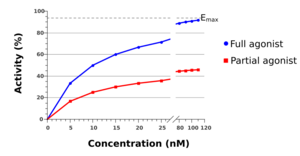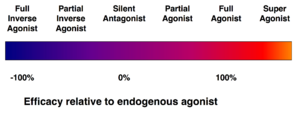Agonist facts for kids
An agonist is a special kind of chemical. Think of it like a key that fits into a specific lock. In your body, these "locks" are called receptors. When an agonist (the key) connects to a receptor (the lock), it "switches on" that receptor. This causes a specific action or response in your body.
So, an agonist makes something happen. But there are also other chemicals that work differently. For example, an antagonist is like a key that fits the lock but doesn't turn it. It just blocks the real key (the agonist) from getting in. There are also inverse agonists, which are like keys that turn the lock the opposite way, causing the opposite action.
These different chemicals help your body control many important processes. Being able to start, stop, or change activities is how your body keeps everything balanced and working well. This balance is called homeostasis.
Contents
What Are Agonists?
Receptors in your body can be turned on by different kinds of agonists. These can be chemicals your body makes naturally, or they can come from outside your body. Both types cause a biological response, meaning they make something happen in your body.
Natural Agonists
Your body makes its own agonists. These are called endogenous agonists. They include important chemicals like hormones and neurotransmitters. Hormones send messages through your blood, while neurotransmitters send messages in your brain and nervous system.
Outside Agonists
Agonists that come from outside your body are called exogenous agonists. Many medicines are examples of these. They are designed to act like your body's natural chemicals to help you.
Sometimes, a substance can cause the same effects in your body but does not connect to the same receptor. This is called a physiological agonist. It means it causes a similar body response through a different pathway.
Examples of Agonists
- Your body naturally produces serotonin. Serotonin is the natural agonist for serotonin receptors. This means it's the key that fits and turns on those specific locks.
- In the same way, dopamine is the natural agonist for dopamine receptors. It helps control things like movement and feelings of pleasure.
- Morphine is a medicine that comes from outside the body. It is an exogenous agonist. It works by acting like your body's natural pain-relieving chemicals, called endorphins. Morphine connects to the same receptors in your central nervous system that endorphins normally use, helping to reduce pain.
Images for kids
See also
 In Spanish: Agonista para niños
In Spanish: Agonista para niños




